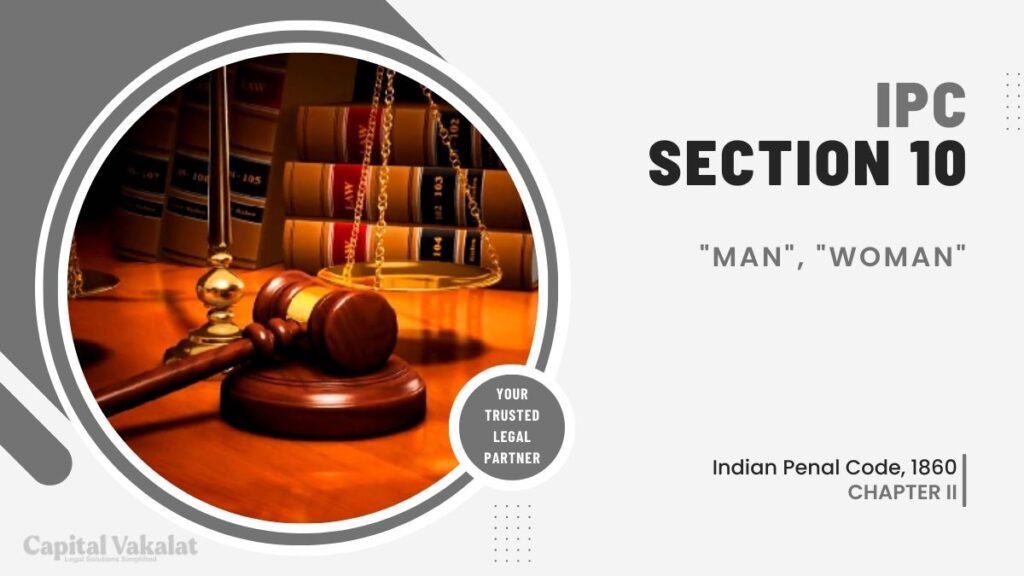In the realm of legal systems, Section 10 of the Indian Penal Code (IPC) stands as a crucial and multifaceted provision that addresses the concepts of “man” and “woman.” With society evolving and notions of gender undergoing transformative shifts, this segment of the IPC has garnered significant attention.

This article delves into Section 10 IPC, dissecting its nuances and implications in today’s context.
Understanding Section 10 IPC
Defining the Terminology
Section 10 of the IPC deals with the definitions of “man” and “woman.” In a legal context, clarity in terminology is paramount. The provision establishes that the words “man” and “woman” are intended to include both adult males and females, respectively.
Recognition of Gender Diversity
In light of the contemporary understanding of gender as a spectrum, Section 10 IPC demonstrates a traditional perspective. While it acknowledges the binary classification, legal discourse is increasingly embracing the complexities of gender identity and expression.
Historical Significance
Tracing the Origin
The origins of Section 10 IPC date back to the enactment of the Indian Penal Code in 1860 during British colonial rule. The legislative intent of the provision was to establish a straightforward classification to ensure legal clarity in a society marked by traditional gender norms.
Evolutionary Trends
Over the years, societal attitudes towards gender have transformed significantly. The static definitions outlined in Section 10 have prompted debates on the need for legal reforms that reflect the diversity of gender experiences in the modern era.
Relevance Today
Gender Justice and Equality
The contemporary discourse on gender revolves around justice and equality. Section 10 IPC’s adherence to binary gender definitions has spurred discussions on how legal frameworks can better protect and acknowledge individuals of all gender identities.
Legal Loopholes and Challenges
Critics argue that Section 10’s rigidity can lead to legal ambiguities. Cases involving transgender and non-binary individuals often raise questions about proper classification and treatment under the law, highlighting the necessity for amendments.
Need for Reform
Inclusive Legal Language
To ensure inclusivity and equality, legal systems worldwide are amending terminologies. In this context, there’s a growing demand to revisit Section 10 IPC and adopt language that encapsulates the diversity of gender experiences.
Embracing Complexity
As societal awareness grows, the law must reflect the evolving understanding of gender. Reforming Section 10 would not only bridge legal gaps but also foster an environment where all individuals are recognized and protected.
Future Prospects
Legal Evolution
The prospect of revising Section 10 IPC presents an opportunity for the legal system to evolve. Adapting to societal changes through comprehensive reforms will fortify the principles of justice and equality.
Collaborative Efforts
Stakeholders, including legal experts, activists, and policymakers, need to collaborate to draft amendments that encapsulate the myriad dimensions of gender while maintaining legal clarity.
Conclusion
Section 10 IPC, a relic of its time, sparks contemplation on the role of law in shaping societal perceptions of gender. In today’s dynamic world, where the understanding of gender is multifaceted, there’s a compelling need for legal provisions that embrace diversity and offer equitable protection.
Certainly! Here are some external resources that provide further details on the topic of Section 10 IPC and gender definitions:
- Indian Penal Code (IPC) – Section 10: Access the official text of Section 10 IPC, which defines the terms “man” and “woman” in the Indian legal context.
- Transgender Persons (Protection of Rights) Bill, 2019: This act addresses the rights and recognition of transgender individuals in India, shedding light on legal developments beyond Section 10 IPC.
- The Evolving Understanding of Gender: Legal and Societal Perspectives: An academic paper exploring the intersection of law and evolving gender concepts, providing insights into the challenges and possibilities for legal reform.
- Gender Identity and the Law: A Guide for Judges and Lawyers: This guide examines how legal systems worldwide are adapting to address gender identity issues, offering a global perspective on legal developments.
These resources provide a comprehensive understanding of the complexities surrounding Section 10 IPC and its implications for gender definitions and legal reform.
FAQs
Can Section 10 IPC be challenged in court?
Yes, any provision of law can be challenged if it is believed to be unconstitutional or discriminatory.
Are there countries with more inclusive legal definitions of gender?
Yes, several countries have adopted more inclusive legal language that recognizes a spectrum of gender identities.
What role do societal perceptions play in the interpretation of Section 10 IPC?
Societal perceptions can influence how legal provisions are interpreted and applied, especially when dealing with gender-related matters.
How can individuals contribute to the reform of Section 10 IPC?
Individuals can engage in discussions, raise awareness, and advocate for legal reforms that reflect contemporary understandings of gender and inclusivity.